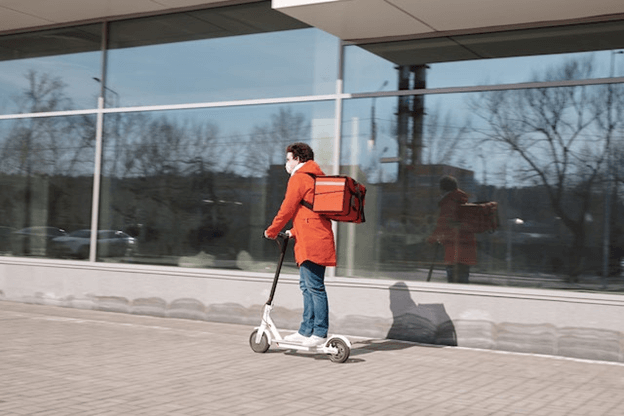Useful Tips For Food Delivery Business in 2023

In recent years, the food delivery industry has experienced a meteoric rise, forever transforming the way we satisfy our culinary cravings. We can now access a vast array of delicious cuisines from the comfort of our homes or offices with just a few taps on our smartphones. This remarkable growth is not without reason. Statista indicates that the revenue in the Online Food Delivery market is projected to reach US$1.02tn in 2023.
As the competition intensifies, it becomes crucial for food delivery businesses to stay ahead of the game and cater to the evolving needs of their customers. In this blog, we will delve into a treasure trove of useful tips and strategies that can elevate your food delivery business to new heights of success.
So, if you’re ready to tantalize your taste buds and make a mark in this booming industry, let’s start!
Food delivery tips to supercharge your business
1. Embrace technology
In the digital age of 2023, food delivery businesses must fully embrace the potential of technology. The first step is establishing an online presence with a professional, user-friendly website and mobile app. These platforms should provide seamless navigation, easy ordering, and secure payment options. Integrating with popular food delivery platforms(such as DoorDash, and Zomato) is equally important to reach a broader customer base and increase visibility.
But just being online is not enough. Advancements in Artificial Intelligence (AI) and data analytics offer invaluable tools to understand customer behavior, preferences, and purchasing patterns. Analyzing this data lets you personalize your marketing efforts, recommend dishes based on past orders, and predict future trends. This personalized experience not only enhances customer satisfaction but also drives customer loyalty.
2. Prioritize sustainability
The growing environmental consciousness of customers is transforming the way businesses operate. For food delivery services, this necessitates a shift towards sustainable practices. Begin by choosing eco-friendly packaging options – these could be biodegradable, compostable, or made from recycled materials. This move reduces the carbon footprint and positions your brand as environmentally responsible.
Minimizing food waste is another key aspect. Implement strategies such as predictive ordering and portion control to reduce overproduction. Energy-efficient practices, such as using electric delivery vehicles or energy-saving appliances, can significantly lower your business’s environmental impact.
Aligning with suppliers who uphold these green values is crucial. Source locally where possible to reduce transportation emissions and support local economies.
3. Diversify menu options
The culinary world is as diverse as the people it serves. As dietary preferences and restrictions become increasingly varied, a one-size-fits-all approach to menu planning is no longer viable for food delivery businesses. Incorporating a range of options, such as vegan, gluten-free, and ethnic dishes, is essential to cater to your customers’ individual needs and preferences.
In addition to variety, maintaining menu relevance is key. Actively seek and incorporate customer feedback to understand which dishes resonate with your clientele and which could be improved. Stay ahead of emerging food trends to keep your menu exciting and fresh, regularly introducing new dishes or flavors to keep customers intrigued.
4. Invest in training
In the food delivery business, customer service is often the differentiator between you and your competitors. It plays an integral role in shaping the customer’s overall experience and directly impacts your brand reputation. Therefore, investing in regular training for your employees, especially your delivery personnel, is paramount.
These training sessions should cover effective communication skills, customer complaints, conflict resolution, and basic etiquette. Providing excellent service goes beyond timely delivery; it’s about making customers feel valued and understood.
Moreover, remember that your delivery personnel are the face of your company in the field. Their customer interaction directly represents your brand, and positive interactions can significantly enhance brand perception.
5. Streamline delivery operations
Timely delivery is one of the cornerstones of a successful food delivery business. In a world where customers value speed and efficiency, slow or late deliveries can significantly affect your brand’s reputation. That’s why investing in route optimization software is critical.
Route optimization software uses sophisticated algorithms to determine the most efficient routes for your delivery personnel. It considers various factors such as road conditions, traffic, and the location of multiple deliveries, ultimately saving time, fuel, and resources. This efficiency directly translates into faster deliveries, which results in happier customers.
6. Collaborate with local businesses
The farm-to-table movement continues to gain traction, with consumers increasingly valuing locally sourced, fresh ingredients. Partnering with local farms, breweries, and other food businesses can significantly elevate the appeal of your food delivery service. Offering locally sourced meals assures customers of the freshness and quality of your food and provides unique flavors and dishes that differentiate your service from competitors.
Collaborating with local suppliers also has the added benefit of supporting your local economy. It fosters relationships within your community, helps sustain local businesses, and often reduces your carbon footprint due to shorter supply chains.
7. Utilize social media
Platforms such as Instagram, Facebook, and Twitter offer an excellent avenue for food delivery businesses to connect with their customers directly. These platforms allow you to showcase your offerings through attractive images and videos, share customer testimonials, and promote special deals or new menu items.
Moreover, social media allows for two-way communication, facilitating direct customer engagement. Responding to real-time comments, messages, and reviews helps build a personal connection with your customers and improve your brand’s reputation.
8. Implement a loyalty program
In a highly competitive food delivery market, retaining existing customers is just as important, if not more so, than attracting new ones. A loyalty program is one of the most effective ways to increase customer retention. By offering rewards such as discounts, free items, or exclusive deals after a certain number of orders, you incentivize customers to choose your service repeatedly.
These programs foster a sense of value and appreciation in your customers. The more they order, the more they’re rewarded, creating a positive cycle that encourages repeat business. Furthermore, a well-structured loyalty program can turn regular customers into brand advocates, who may recommend your service to their network.
Bottom-Line
Adaptation and innovation are the two main key strategies to thrive in the food delivery business. As we step into 2023, the industry’s potential for growth and profitability remains undeniable, but so does the competition. By implementing the valuable tips and strategies shared in this blog, your food delivery business can not only survive but thrive in this ever-evolving landscape.
However, none of this can be achieved without a solid digital foundation. If you’re looking for a partner to help bring these strategies to life, ScrumDigital is an industry leader in developing comprehensive, user-friendly food delivery apps. Their team can help you streamline your operations, improve customer engagement, and ultimately drive your business growth.




